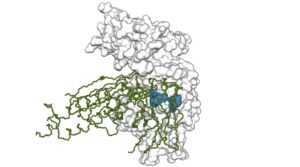(Sponsored)
We caught up with Enrique Jambrina, PhD, Chief Scientific Officer at In Silico Discovery to find out more about their approach, benefits for end users and future trends
In-Silico Discovery is one of these trailblazing start-ups that designs cosmetic actives with computational techniques – can you tell us more about the company’s DNA?
The people behind ISD are really the engine that made this company a reality.
José María García Antón, the founder, is a well-known entrepreneur known for efficiently translating scientific research into marketed products (i.e.: Lipotec, LipoTrue The Deep Blue Sea Enterprise, PrimaDerm, etc).
He was the first one to think of taking advantage of the knowledge developed by pharmaceutical companies when approaching a disease through a specific protein or mechanism of action, and the possibilities that applying those technologies could offer for the cosmetic and biotechnological fields.
Around this original concept he has been able to gather people with experience in the cosmetic field, in the creation of biotechnology-based start-ups, in pharma project design and execution, and, in computational drug discovery and design – the latter being possible through a solid technological partnership with Nostrum Biodiscovery.
As a brand-new company, the technological advances in the field of computer science offer us the possibility to efficiently identify new active molecules through virtual screening and de novo design without the need to run costly experiments.
In Silico Discovery (ISD) was then founded with the objective of developing a target-based computational approach for the efficient discovery of new potential actives with application in the cosmetic and biotechnological areas.
What makes In-Silico Discovery’s offering so unique?
We have built our own portfolio following a target-based approach. We have a strong interest in modulating the activity of the different cell types found in the epidermis (Merkel, Langerhans, melanocytes and keratinocytes) as well as in the communication between the nerve endings and these cells.
We have focused our first set of targets on the keratinocytes stem cell population present in the basal cell layer, which has been described as decreasing during ageing.
With this objective in mind, we have navigated through scientific literature to identify targets (proteins) which would have a role in controlling the functionality of this cell population, mainly through their proliferation and barrier functions.
Those selected targets are then modelled in-silico and analysed in the search for possible binding sites where our new molecules will be directed, potentially affecting its conformation and then its function.
The collaboration with Nostrum Biodiscovery gives us access to a series of proprietary algorithms such as PELEplat, pyDock and ED/MD Suite Simulation as well as their knowledge around ligand-protein interactions.
There are a few companies that offer computational services, but we are unique in offering our own selection of actives selected with proprietary in-silico tools, algorithms and molecule virtual libraries.
What are the key benefits for end users?
This in-silico approach focused on a specific target protein offers a highly efficient method in the early stages of active ingredients identification, speeding up discovery and avoiding the use of precious experimental resources, which can be focused on key experiments.


This methodology also provides a strong scientific hypothesis about the mechanism of action for these new cosmetic actives.
From our own experience, the projects can take 3 to 6 months depending on the target and the strategy followed which could be based in the identification of small peptides as binders of the protein of interest or the design of a novel small protein that will mimic the function of the original target, and which is easier to obtain than the original one.
Before starting any of our projects we perform a patent search to guarantee a significant level of freedom to operate. Lastly, our clients will find a list of novel molecules selected by the most advanced in-silico algorithms predicting their binding properties, ready to be synthesized, tested, and incorporated in their formulations.
Our findings and the strategy followed to identify those actives are protected by Trade Secret offering the end-users the possibility to fulfil a patent.
What does the future look like for In-Silico Discovery? What future trends can you predict in the world of cosmetic actives design?
Over the past few years, there has been an exponential increase in the knowledge of the mechanisms and genes involved in the ageing process and their implication in the origin and progression of different diseases such as oncology, inflammation, and neurodegeneration.
This interest has been echoed in the creation of new scientific journals (i.e.: Nature Aging), and the creation of companies like Altos Labs, focused on cellular rejuvenation programming.
Keeping a broad point of view when designing future cosmetic formulations will then be critical in order to apply those findings from other scientific areas into the cosmetic sector.
Topics such as senescence, autophagy, or mitochondria health are already of interest in the maintenance of skin homeostasis and such processes could be influenced by specific proteins whose functions we will be able to modulate.
On the other hand, the continuous and fascinating developments in the AI and machine learning fields, such as the design of de novo proteins, or the combination of different activities in just one molecule, will offer new and exciting ways to identify new actives in a very effective manner.
It will also continue to offer a new perspective on the modulation of those signalling pathways essential for skin health.

Find out more about In-Silico Discovery
Enjoyed this article? Get more by subscribing to our newsletter!
Feeling inspired to see ingredients and trends in action?
Then why not visit one of the in-cosmetics events around the world?

